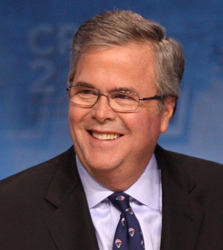
No Need for Bush Campaign to Pull the Plug
The last several months have not been kind to former Florida Gov. Jeb Bush, as his campaign has morphed from frontrunner status to the middle-of-the-pack. Combined with debate performances that don’t seem to have impressed many, the Bush campaign is reassuring donors and pushing back hard against suggestions it may be time for him to follow Rick Perry and Scott Walker in exiting the race, as reported by Bloomberg Politics:
Jeb Bush Tries to Reassure Jittery Donors After Lackluster Debate
Bush delivered his latest glass-half-full message on a Thursday afternoon conference call, one day after Wednesday night's admittedly sub-par debate performance, as some of his financiers worry that his move to confront one-time protégé Senator Marco Rubio backfired badly. During the short call with his top donors, Bush acknowledged the debate wasn't his best and vowed to “improve every day,” according to one donor given anonymity to discuss the private conversation. The donor described Bush as sounding upbeat and eager to return to the campaign trail….
Earlier this week Bush’s team gathered in Houston to reassure donors and outline the path forward for the campaign. The full 112-slide PowerPoint presentation that they delivered to nervous donors wound up in the hands of the press, and as reported by U.S. News & World Report, it lays out a revised plan based on the current campaign dynamics:
An internal poll conducted by Bush's campaign of the New Hampshire primary on Oct. 19 and 20 showed Ohio Gov. John Kasich tied with Bush for third place….
The campaign measured Bush's favorability rating to be 59 percent, behind Carson's 67 percent but closer to Rubio's 62 percent, Carly Fiorina's 60 percent and Trump's 57 percent. Kasich's favorability is glaringly not included on the slide. But a separate page blares: "Jeb Taking Kasich Voters in NH" and shows their recent trajectories in public polling….
Other slides were inserted to ease anxiety, including one noting that early polls are volatile and have produced a "carousel of frontrunners."
Internal Bush polling also found that only a minuscule amount of voters had "firmly decided" on a candidate, but that Trump counted the most supporters who had made up their mind, at 9 percent.
While tied for third place in New Hampshire may seem like a poor showing, it’s worth remembering that there are half a dozen candidates who would figuratively give their right arm to have Bush’s poll numbers. The U.S. News story continues to describe how Bush’s team plans to move up:
The Bush campaign has allotted $10.8 million for an advertising blitz to begin just after the new year, on Jan. 5.
The biggest investment is in New Hampshire, which will vote Feb. 9. Bush has slated $5.6 million for five weeks of broadcast and cable television, radio and digital advertising purchases. The Granite State is seen as close to a must-win for Bush as anything could be. He's made 16 trips there so far, according to The Chase presidential tracker – double the time that he's spent in Iowa.
Bush also will spend $2.7 million on commercials in South Carolina over a seven-week span, ahead of the Feb. 20 first-in-the-South primary.
He's devoting just $1.4 million to Iowa over the four weeks ahead of the Feb. 1 caucuses.
The lesser emphasis on Iowa is explained by the Bush campaign’s assessment that he isn’t a good fit for many of Iowa’s voters:
The Hawkeye State has always been a lesser priority for Bush, who has struggled to connect with the heavily evangelical, highly ideological base there. The blueprint underscores the delicate balancing act the campaign is seeking in Iowa – not completely writing it off but not going all in, either.
In 2012, Rick Santorum won the caucuses with 29,839 votes. Second-place Mitt Romney was just behind with 29,805.
Confronting a larger field and higher hurdles there, Bush is lowering expectations significantly, but still believes he can reach double-digits.
It’s clear that the Bush campaign is not where they hoped or expected to be at this point. It should also be clear that the 2016 presidential race is a little unusual because of the high degree of antagonism many Republican voters feel toward candidates seen as “establishment” figures, as shown by the fact that the combined poll numbers of businessman Donald Trump, retired neurosurgeon Ben Carson, and businesswoman Carly Fiorina tops 50 percent.
But as the Bush PowerPoint notes, in 2012 at this point the leading GOP candidate was Herman Cain and in 2008 it was Rudy Giuliani. Things can change very quickly during the nomination process, and while the “turtle” approach of the Bush campaign hasn’t won rave reviews to date, the ability to simply persevere is a valuable one, and it’s too early to be calling for a candidate currently sitting in the top five in national polls (in the RealClearPolitics.com average of polls, he is just behind Texas Sen. Ted Cruz and just ahead of Fiorina) when there are 15 candidates vying for the nomination.



